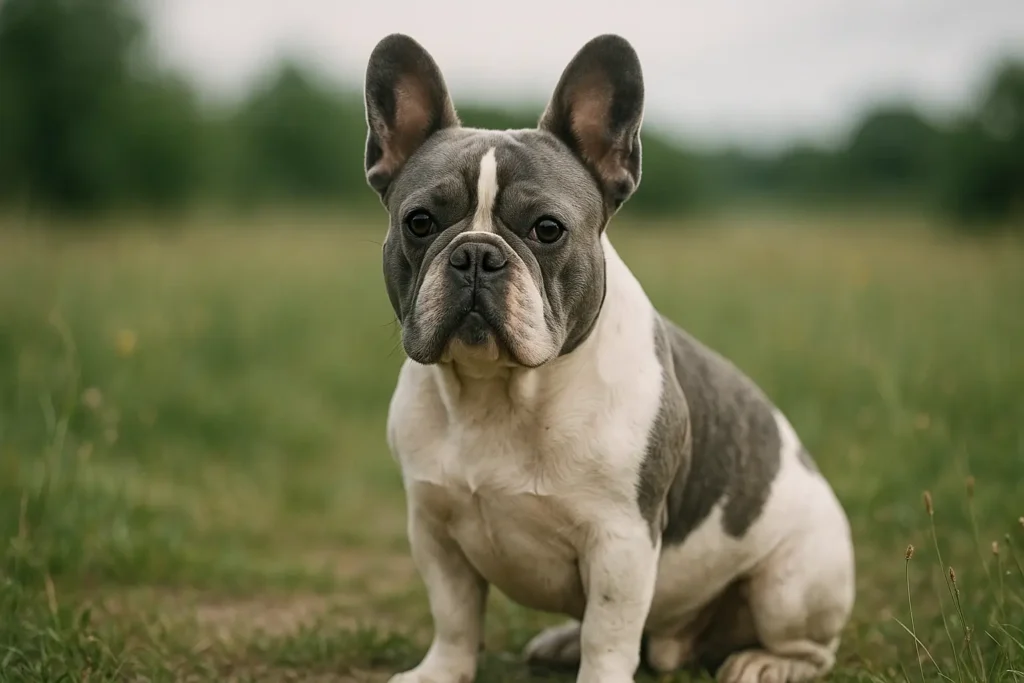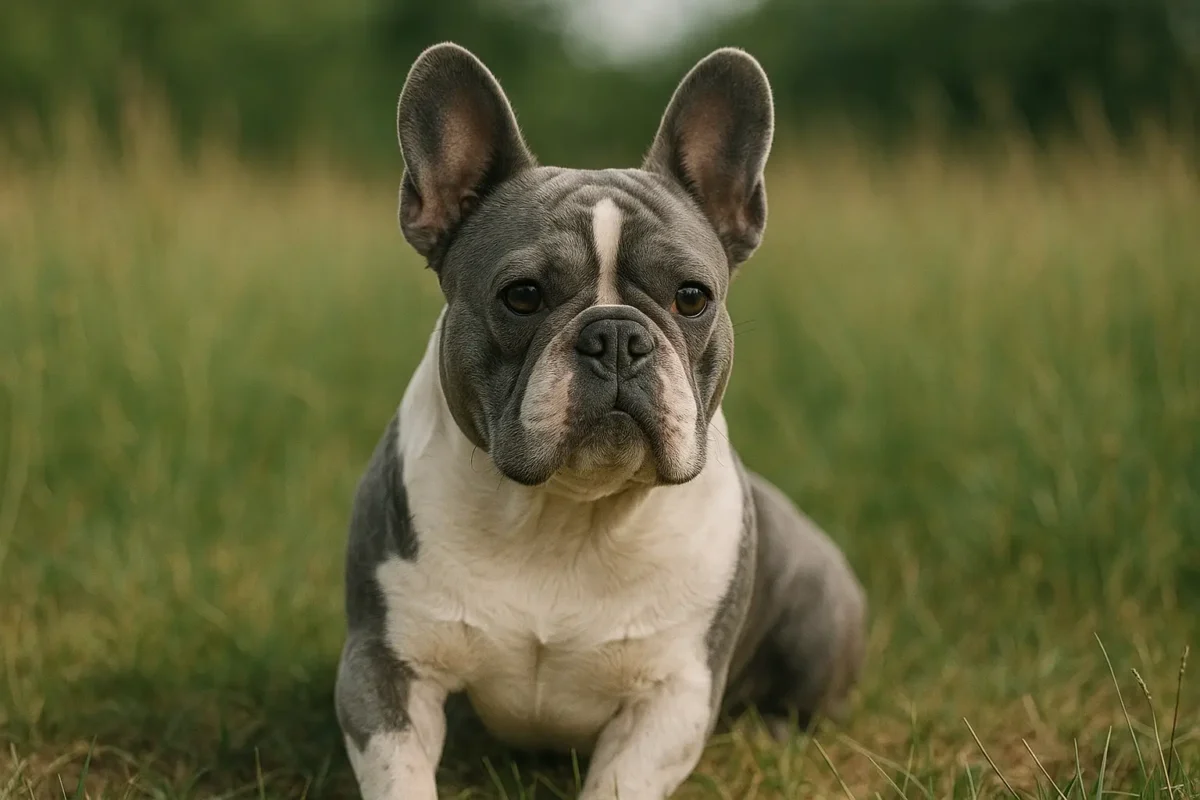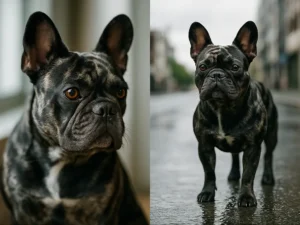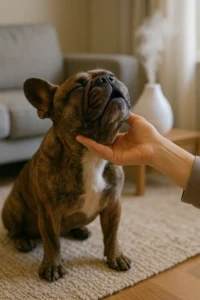Quick Answer
A pied Frenchie has a mostly white coat with colored patches. The word blue doesn’t mean “sad” or “rare”—it’s a color made by diluted black pigment, which looks slate or steel gray. Put together, “blue pied” mixes a pattern (pied) with a color (blue). Major registries accept pied, but do not accept blue.
TL;DR
- Pied = pattern. White is the main color; large patches show on top.
- Blue = color. It’s diluted black pigment that looks gray/blue.
- Registry stance: AKC and FCI do not accept blue/blue fawn; The Kennel Club (UK) lists brindle, fawn, pied as accepted and calls other colors unacceptable.
- Photo ID tip: shoot in daylight on a plain background; capture nose leather and eye rims to record pigment.
- Paperwork first: check official wording on AKC, The Kennel Club (UK), or FCI documents—avoid “rare color” hype.
What “Blue Pied” Really Means?
People often mix up pattern and color.
- Pied tells you how the coat is arranged: a mostly white dog with clear patches of another color. The patches themselves might be brindle (dark hairs mixed with lighter) or fawn (warm, yellow-red).
- Blue tells you which pigment is showing: black pigment that has been diluted so it looks slate/steel gray.
So a “blue pied” Frenchie is simply a pied pattern where the patches look gray/blue. That’s all. It’s not a special category or a new breed.

Visual ID Guide
What to look for on the coat
- Base color: White is the majority of the coat.
- Patches:
- Brindle patch = you’ll see dark hairs with lighter hairs mixed in (striped look).
- Fawn patch = even warm color (tan to red).
- “Blue” patch = looks slate or steel gray (that’s diluted black).
- Mask: Some fawn or brindle patches include a dark muzzle (“mask”). A “blue” mask would look gray-toned rather than black.
- Edges & overlay: Patches should have clear edges. If a patch is brindle, you’ll notice fine striping inside the patch.
Photo ID Tips (Checklist)
- Lighting: Bright, indirect daylight (avoid yellow or colored bulbs).
- Background: Plain wall that contrasts with the coat (light background for brindle; mid-tone for cream/fawn).
- Angles:
- Front (face and chest)
- Left profile and right profile
- Full-body side
- Top-down (helps show patch layout)
- Close-ups: Nose leather, eye rims, lips, and the edge of a patch (to see brindle striping vs solid fawn).
- File names: “DogName_Date_View.jpg” — easy to find when you need to show a breeder, rescue, airline, or registry.
Standards Snapshot
A quick view of what top registries say about colors and pied.
| Registry | Accepted wording | Notes |
|---|---|---|
| AKC (U.S.) | Recognizes pied (e.g., brindle pied, fawn pied). | Disqualifies blue/blue fawn. See the official standard (PDF): images.akc.org/pdf/breeds/standards/French_Bulldog-6-18.pdf. |
| The Kennel Club (UK) | Brindle, fawn, pied. | “Any other colour” unacceptable. Pigment notes (eye rims/lips ideally dark): thekennelclub.org.uk. |
| FCI | Standard No. 101 lists accepted colors and patterns. | Disqualifies “mouse grey” (another term for blue dilution). PDF: fci.be. |
(Use these pages for official wording and general identity—not for medical advice.)
Genetics (just the basics)
Dogs mainly show two pigments in fur:
- Eumelanin — black/brown-based pigment
- Phaeomelanin — red/yellow-based pigment
- Pied is a pattern (white background with patches). It doesn’t tell you which pigment is in the patches.
- “Blue” is diluted black pigment. At a high level, genes at the D-locus can dilute black so it looks slate/steel gray.
- Fawn and brindle are shaped by other genes (including ASIP/agouti) that affect where red/yellow vs dark pigment appears.
If you want a friendly explainer (no breeding or medical advice), see UC Davis Veterinary Genetics Laboratory’s coat color overview:
https://vgl.ucdavis.edu/resources/dog-coat-color
Myths & Mislabels
- “Blue pied is a separate, special color class.”
It’s just pattern (pied) + color (blue). “Blue” is not accepted by major registries for French Bulldogs. - “Blue is rare and therefore better.”
Registries list blue/mouse grey as disqualified. Quality is about sound structure, type, and temperament—not buzzwords. - “Pied means random spots of any color.”
Registry pied follows rules. Patches usually fall into brindle or fawn families, with pigment guidance (for example, dark eye rims are preferred wording in UK notes). - “Paperwork doesn’t matter.”
It matters. Registry documents use specific terms. If a seller’s wording doesn’t match AKC/KC/FCI language, ask questions or walk away.

Buying & Adoption Tips (Ethics-First)
- Verify registration wording. If someone claims registry status, ask to see official papers from the AKC, The Kennel Club (UK), or an FCI member club. The wording should match the standard.
- Ask for clear photos. Request the angles from the Photo ID checklist above, especially nose leather and eye rims.
- Avoid color-only decisions. A dog isn’t “better” because a listing says “blue pied.” Focus on temperament, fit for your home, and honest paperwork.
- Consider reputable rescues or breeders. Use registry/breed-club directories to start your search and to find local clubs that can answer questions.
- Keep copies. Store digital scans of registration, pedigree (if available), and your photo set. It speeds up travel, rentals, and ID checks.
Light Care Basics
Coat care: Short, smooth coat—weekly brushing keeps shedding tidy.
Grooming rhythm: Gentle face/ear wipe-downs; regular nail care; simple bath routine.
Home environment: Cool, well-ventilated resting spots and a steady daily routine support comfort.
For health concerns, consult your veterinarian.
FAQs
What does “pied” actually mean in French Bulldogs?
“Pied” means the pattern: a white base with clear color patches. The patches can be brindle (striped look) or fawn (warm tan to red). Pied does not say which color—only how the coat is arranged.
How can someone tell fawn pied from brindle pied in photos?
Zoom in on a patch. Brindle shows tiny dark stripes or a salt-and-pepper look. Fawn looks even and warm without striping. Good lighting and a plain background make this easier.
Why do some patches look gray or blue?
That gray/blue look is diluted black pigment. It’s a color, not a pattern, and it comes from genes that reduce the intensity of black (often discussed at the D-locus).
Are blue or blue pied Frenchies recognized by major registries?
No, top registries don’t accept blue. The AKC disqualifies blue/blue fawn. The FCI disqualifies “mouse grey” (another word for blue). The Kennel Club (UK) lists brindle, fawn, pied and says other colors are unacceptable.
What should registration paperwork say for a pied Frenchie?
You should see wording that aligns with the standard (for example, brindle pied or fawn pied). If a document says “blue” as a color description, that won’t align with AKC/FCI rules.
Do pigment points (nose and eye rims) matter for identification?
Yes, it may help you understand what pigment is present. For pied, some registries prefer dark eye rims and lips. Close-up photos of nose leather and eye rims are very useful in records.
How do I take useful photos for records or a breeder/rescue?
Use bright daylight, a plain background, and shoot front, both profiles, full side, top-down, plus close-ups of pigment points and a patch edge. Name files clearly so you can find them later.
Key Takeaways
- Pied is a pattern; blue is a color made by diluted black pigment.
- Major registries accept pied, but do not accept blue (called mouse grey by FCI).
- Use good photos and paperwork to describe a dog clearly—avoid “rare color” marketing.
- For buying or adopting, check AKC/KC/FCI wording first; don’t make decisions based on color hype alone.
Sources Used (clean, official)
- AKC — Official French Bulldog Standard (PDF): https://images.akc.org/pdf/breeds/standards/French_Bulldog-6-18.pdf
- AKC — Breed page: https://www.akc.org/dog-breeds/french-bulldog/
- The Kennel Club (UK) — French Bulldog Breed Standard: https://www.thekennelclub.org.uk/breed-standards/utility/french-bulldog/
- FCI — French Bulldog Standard No. 101 (English PDF): https://www.fci.be/nomenclature/standards/101g09-en.pdf
- FBDCA — Breed Standard / Color resources: https://frenchbulldogclub.org/breedstandard/ • https://frenchbulldogclub.org/color/ • https://frenchbulldogclub.org/nofadcolors/
- UC Davis Veterinary Genetics Laboratory — Coat Color Overview: https://vgl.ucdavis.edu/resources/dog-coat-color
Disclaimer
This article offers general-information about color and pattern terminology and how registries describe them. It is not medical, legal, or professional advice. For any health or legal questions, talk to qualified professionals.



